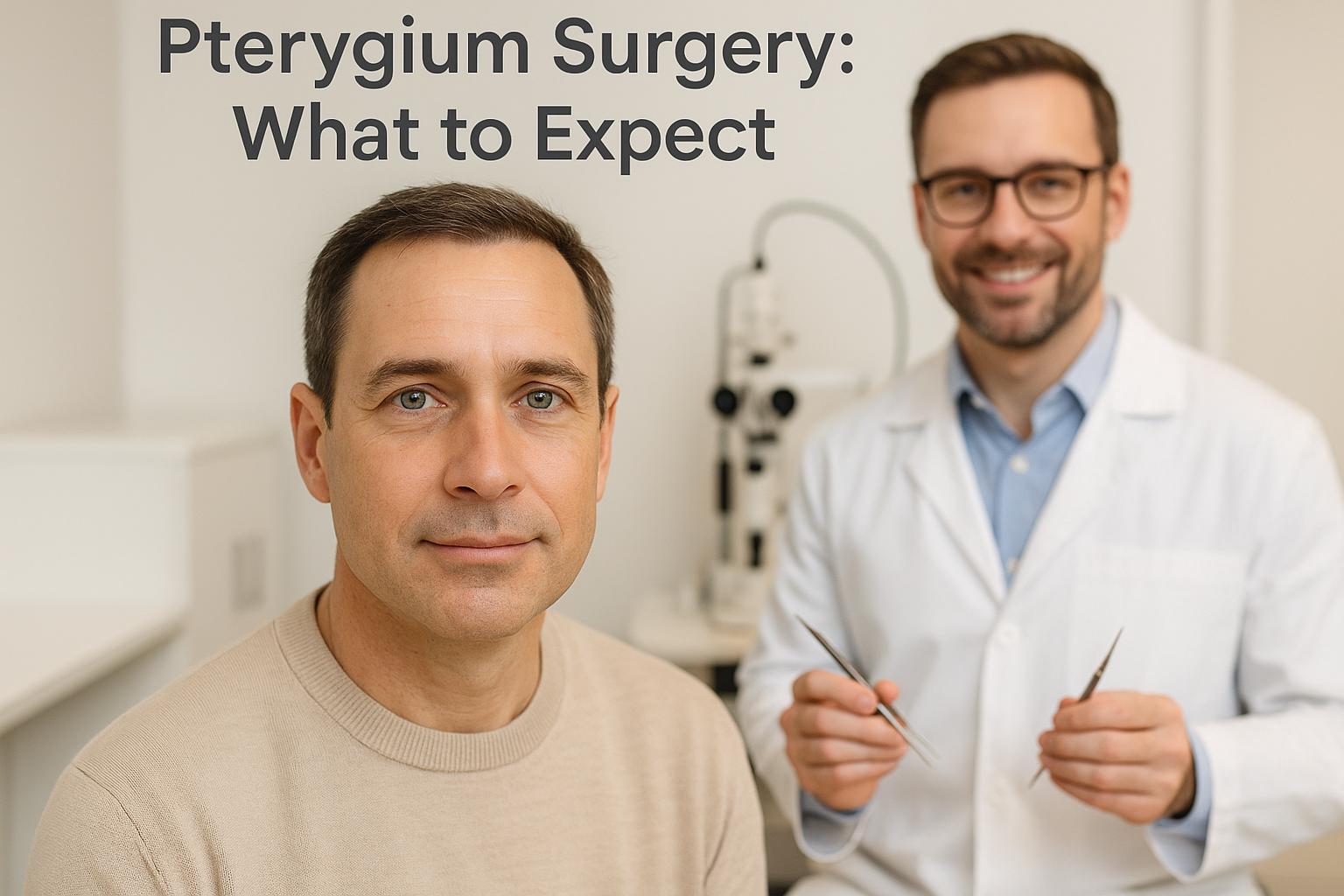Pterygium surgery is a procedure to remove a non-cancerous growth on the eye, typically caused by prolonged UV exposure, dust, or wind. Symptoms like redness, irritation, or blurred vision often lead to surgery, especially when vision is impaired or discomfort persists despite medication. Here’s what you need to know:
- When Surgery is Needed: Recommended for vision issues, chronic discomfort, or cosmetic concerns.
- Preparation: Includes a detailed eye exam, medication adjustments, fasting (if sedation is used), and arranging transportation.
- The Procedure: Involves removing the growth and placing a graft to reduce recurrence. Local anesthesia and mild sedation ensure comfort.
- Recovery: Expect mild redness, blurred vision, and light sensitivity. Most return to normal activities within 1–2 weeks. Follow-up care and prescribed eye drops are crucial.
- Risks and Results: Recurrence is rare with modern techniques, and most patients experience improved vision and reduced symptoms within weeks.
Consult an experienced surgeon and follow care instructions to achieve the best results.
Ptergyium Surgery – Before and After. What is it? How we remove it. Recovery and Results.
How to Prepare for Pterygium Surgery
Once diagnosed, preparing for pterygium surgery involves a detailed examination and following specific pre-surgery instructions. These steps are essential to ensure the procedure goes smoothly.
Pre-Surgery Eye Exam
Your surgeon will begin with a thorough eye exam to evaluate the pterygium and plan the surgery. This includes assessing your vision and examining the structures of your eye in detail.
A corneal topography might be performed to check for any changes in the cornea’s shape caused by the pterygium.
Your medical history plays a crucial role in surgical planning. Be ready to discuss all current medications – prescriptions, over-the-counter drugs, and supplements. It’s also important to inform your doctor about any allergies, particularly to anesthetics or antibiotics. If you’ve had previous eye surgeries or have chronic conditions like diabetes or autoimmune disorders, make sure to share that information, as it can influence surgical decisions.
If you have a history of bleeding disorders or take blood-thinning medications, your surgeon will collaborate with your other healthcare providers to determine if any changes to your medication regimen are needed before the procedure.
At Boulder Eye Surgeons, advanced technology is used during these preoperative exams to craft a personalized treatment plan. This meticulous approach supports better outcomes for patients in Boulder, CO, and nearby areas.
Before Surgery Instructions
Preparing for surgery also involves following specific pre-operative guidelines. These include fasting, adjusting medications, and avoiding certain products to reduce risks.
Fasting requirements depend on the type of anesthesia being used. If sedation is planned, you’ll likely need to fast for several hours before the procedure. For surgeries using only local anesthesia, a light meal may be permitted.
Medication adjustments might also be necessary. Your surgeon may advise temporarily stopping blood thinners like aspirin or anti-inflammatory medications to lower the risk of bleeding during surgery. Always consult both your surgeon and the prescribing doctor before making any changes to your medication routine.
On the day of surgery, avoid wearing makeup, lotions, or creams on your face and around your eyes. This helps reduce the risk of infection and ensures a clean surgical area. Wear comfortable clothing, and remember to bring a valid photo ID and your current insurance card to the appointment.
Transportation is a must. Since sedation or anesthesia can cause drowsiness and blurred vision, you won’t be able to drive yourself home. Arrange for a responsible adult to accompany you to the surgery and drive you back. Ideally, this person should also stay with you for a few hours afterward to assist with any immediate needs.
Lastly, prepare your recovery space at home. Stock up on essentials like ice packs and any prescribed medications. These preparations will help set you up for a smooth recovery process.
What Happens During Pterygium Surgery
Pterygium surgery is a carefully planned procedure aimed at removing abnormal tissue and reducing the chances of regrowth. The process includes precise steps to ensure comfort and effective results. Here’s what typically happens during the surgery.
Pain Management for Comfort
To keep you comfortable, your surgeon will use local anesthesia, such as a retrobulbar or peribulbar block, often paired with mild sedation to help you relax. This combination ensures pain is well-controlled while you remain awake and responsive throughout the procedure.
Step-by-Step Procedure
The surgery follows a structured process to fully remove the pterygium and minimize recurrence:
- Incision and Removal: The surgeon makes an incision at the limbus, the area where the pterygium meets the cornea. Specialized tools are then used to carefully separate the pterygium tissue from the cornea. To ensure complete removal, a small margin of healthy conjunctiva, about 1 mm, is also excised.
- Corneal Polishing: A diamond burr may be used to polish the cornea, promoting smooth healing after tissue removal.
- Graft Placement: A thin conjunctival autograft, typically taken from the upper conjunctiva, is prepared. This graft is carefully trimmed to exclude Tenon’s layer, which aids in optimal healing. The graft is then placed over the exposed sclera and secured using either fibrin glue or sutures.
Fibrin glue allows for a suture-free application, which can reduce discomfort and speed up recovery, as it sets in about 30 seconds. Sutures, such as 8-0 vicryl, provide strong fixation but may cause more discomfort and require removal later.
| Fixation Method | Benefits | Considerations |
|---|---|---|
| Fibrin Glue | Less discomfort, faster healing | Must be applied quickly; higher cost |
| Sutures | Strong and reliable fixation | May cause more discomfort, slower recovery |
Surgery Duration and Techniques
Pterygium surgery is typically an outpatient procedure, lasting about 30 to 45 minutes. Advanced methods, like the PERFECT technique, may take a bit longer – around 45 to 60 minutes – but offer greater precision and a lower chance of recurrence.
At Boulder Eye Surgeons, advanced technology and minimally invasive techniques are used to ensure each procedure is tailored to the patient’s needs. Strict sterile protocols and minimal use of cautery are employed to enhance healing, delivering both cosmetic and functional benefits.
Once the surgery is complete, you’ll move into the recovery phase, where specific post-surgery care instructions will guide your healing process.
sbb-itb-c87b093
Recovery and Care After Surgery
Recovering from pterygium surgery typically follows a straightforward path. Understanding what lies ahead can help you feel more prepared and make the process smoother.
What to Expect Right After Surgery
It’s normal to experience blurred vision, mild discomfort, and redness in the days following surgery. You might notice a gritty sensation, light sensitivity, or a dull ache – these are all part of the healing process. Severe pain is uncommon, and prescribed eye drops will help manage discomfort and support recovery.
The cornea usually begins to heal within 24 to 48 hours, while the area where the conjunctival graft was taken heals over several days without complications. During this time, your eye may appear redder than usual, but this redness will gradually subside as you heal.
Recovery Time and Daily Activities
Most people can resume light activities, like desk work or walking, within a few days. However, strenuous tasks should be avoided until you’re fully recovered, which typically takes about one to two weeks. For the first week, steer clear of swimming, hot tubs, and heavy lifting to minimize the chance of complications.
Your surgeon will provide specific recovery instructions during follow-up appointments. Pay attention to your body – if an activity causes discomfort, it’s best to hold off and let your eye heal.
Post-Surgery Care Steps
Taking care of your eye after surgery is crucial for a smooth recovery. Your surgeon will likely prescribe antibiotic eye drops, such as a fluoroquinolone, to use four times daily for about a week. Steroid drops, like prednisolone acetate, may also be prescribed to reduce inflammation, with the dosage gradually tapered over one to three months.
To help your eye heal properly:
- Avoid rubbing your eye.
- Wear sunglasses outdoors to protect against light and debris.
- Skip wearing eye makeup for at least a week.
- If tissue glue was used, it will dissolve naturally – use an eye shield at night during the early recovery phase for added protection.
Make sure to attend all scheduled follow-ups so your surgeon can monitor your progress and address any concerns.
Warning Signs to Watch For
While complications are rare, certain symptoms require immediate attention. Contact your surgeon right away if you experience severe pain, sudden vision loss, unusual discharge (yellow or green), or persistent redness and swelling.
Trust your instincts during recovery. If something feels unusual or doesn’t align with your surgeon’s guidance, don’t hesitate to reach out for advice. Following your surgeon’s instructions closely is the best way to ensure a smooth recovery.
For personalized care and expert guidance, you can consult the team at Boulder Eye Surgeons, where patient safety and comprehensive eye care are always a priority.
Surgery Risks, Benefits, and Results
Understanding the benefits, risks, and potential outcomes of pterygium surgery can help you make well-informed decisions about your treatment. While modern surgical methods have improved results, it’s essential to weigh the advantages and possible complications.
Benefits of Pterygium Surgery
One of the primary benefits of pterygium surgery is improved vision. Many patients notice clearer sight within just a few days after the procedure. Additionally, the surgery alleviates common symptoms like irritation, redness, and the uncomfortable sensation of having something in your eye, significantly improving day-to-day comfort.
From a cosmetic perspective, the surgery removes the visible growth, which can enhance the appearance of your eye. This change often boosts confidence, especially for those who have felt self-conscious about the condition.
Modern techniques, such as conjunctival autografting, have also been shown to reduce recurrence rates to as low as 2–5%. While these benefits are significant, it’s equally important to consider potential risks.
Possible Risks and Problems
Like any surgical procedure, pterygium surgery carries some risks. The most common concern is recurrence. For example, simple excision procedures have a recurrence rate of approximately 10%, but advanced methods like conjunctival autografting can lower this risk to 2–5%.
Other potential risks include infection, which can usually be minimized by using prescribed antibiotic eye drops after surgery. Graft displacement is another concern; this occurs if the graft does not adhere properly, which is why following post-operative activity restrictions is crucial.
Scarring may develop at the surgical site, and in rare cases, patients might experience corneal thinning or vision changes if the cornea is inadvertently damaged during the procedure. Some individuals also report prolonged redness or discomfort, though these issues are generally uncommon.
Choosing a skilled surgeon and carefully following pre- and post-operative care instructions can significantly reduce the likelihood of complications.
What Results to Expect
Most patients experience noticeable improvements in vision and comfort within the first month. Studies indicate that recurrence rates can be as low as 8% over 12 months. Additionally, patient satisfaction rates exceed 90%, with many reporting positive changes within just a few days. Full recovery, however, typically takes 4 to 6 weeks.
Mild redness or irritation is normal during the initial recovery period but usually resolves completely over time. Any minor cosmetic differences at the surgical site tend to fade as healing progresses.
While modern techniques have significantly reduced the risk of recurrence, it’s important to note that the possibility still exists. Adhering to post-operative care instructions – such as using prescribed eye drops, wearing UV-blocking sunglasses, and attending follow-up appointments – can greatly reduce the chances of the pterygium returning.
"Patients experience reduced symptoms and enhanced vision with modern techniques."
– Dr. John Smith, Ophthalmologist, Boulder Eye Surgeons
The team at Boulder Eye Surgeons employs advanced surgical techniques and personalized care to help patients achieve the best possible outcomes for pterygium treatment in Boulder, CO, and nearby areas.
Key Points About Pterygium Surgery
Pterygium surgery is a straightforward outpatient procedure, typically lasting 30–45 minutes, that can help alleviate irritation and visual issues caused by this condition. To ensure the best results, it’s important to understand the preparation, surgical process, and recovery steps.
Preparation involves a few essential steps: undergoing a pre-surgery exam, stopping contact lens use at least 24 hours before the procedure, following any fasting instructions provided by your doctor, and arranging for someone to drive you home afterward. These steps help ensure the surgery goes smoothly.
During the procedure, the surgeon removes the abnormal tissue and may place a conjunctival autograft or an amniotic membrane to aid healing. The eye is numbed with local anesthesia, and light sedation is often provided to keep you comfortable throughout. Thanks to modern surgical techniques, the process is efficient and precise.
Recovery happens in stages. Mild discomfort and redness are common initially but usually subside quickly. Most people can return to normal activities within 1–2 weeks, provided they follow post-surgery care instructions. These include using prescribed antibiotic and steroid eye drops, avoiding eye rubbing, and protecting the eye from irritants. Activities like swimming and strenuous exercise should be avoided for at least 1–2 weeks. Attending all follow-up appointments is vital to monitor healing progress.
Be alert for warning signs such as severe pain, sudden vision changes, increased redness or swelling, unusual discharge, or fever. If any of these occur, contact your doctor immediately.
At Boulder Eye Surgeons, advanced surgical techniques and personalized care ensure you’re supported every step of the way – from your initial consultation to full recovery.
FAQs
What should I look for when selecting a surgeon for pterygium surgery?
Choosing the right surgeon for pterygium surgery is a big decision that can impact your results. Start by seeking out a board-certified ophthalmologist who has solid experience with this specific procedure. A surgeon’s skill and background in eye surgeries can greatly influence the success of your treatment.
You’ll also want to take a close look at the clinic itself. Pay attention to its reputation, the technology they use, and the level of personalized care they provide. For instance, places like Boulder Eye Surgeons are recognized for their advanced equipment and customized approach to patient care. During your consultation, don’t shy away from asking questions – it’s your opportunity to ensure you feel informed and confident about your choice.
What can I do to reduce the chances of pterygium coming back after surgery?
To reduce the chances of pterygium coming back after surgery, it’s crucial to protect your eyes and stick to your doctor’s post-surgery care plan. One of the best ways to do this is by wearing sunglasses with UV protection and pairing them with a wide-brimmed hat. This combo helps shield your eyes from harmful UV rays, which are a key factor in recurrence. It’s also a good idea to steer clear of dry, dusty, or windy conditions whenever you can.
Your doctor might prescribe eye drops to control inflammation and aid the healing process. Make sure to use them as directed. And don’t skip your follow-up visits – these appointments let your eye care provider keep an eye on your recovery and quickly address any issues. By following these steps, you’ll lower the risk of recurrence and set yourself up for a smoother healing journey.
What long-term effects can pterygium surgery have on your vision and eye health?
Pterygium surgery is known to be both safe and effective, offering most patients improved eye health and clearer vision after recovery. That said, like any surgical procedure, it can come with some potential long-term effects. In rare cases, patients may experience issues such as recurrence of the pterygium, dryness, or redness in the treated eye.
To reduce these risks and support proper healing, it’s crucial to carefully follow your surgeon’s post-operative care instructions. Regular check-ups with your eye doctor are also essential to monitor your eye health and address any concerns promptly.





